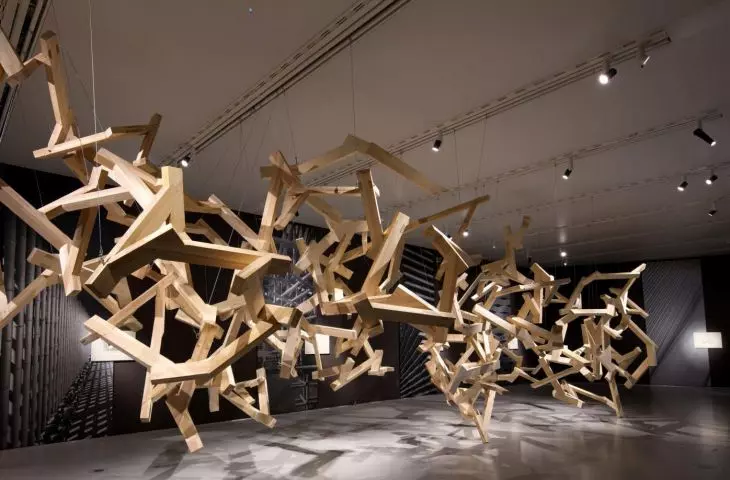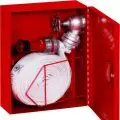interview fromA&B issue 03/2022
Kengo Kuma's architecture is a masterpiece - and so is the exhibition devoted to his work at the Manggha Museum of Japanese Art and Technology in Krakow. In the foreground are large, with attention to detail made mock-ups, mockups of fragments of elevations, and only in the background are photos, plans and texts.
Architectural exhibitions are difficult and often simply boring. Looking at projections, sections and sketches probably appeals only to architects, photos in a larger selection are offered by the Internet, while the strength of a museum is contact with the original. That tangible element in the exhibition "Kengo Kuma. Experiment. Material. Architecture" are real-scale fragments of the facades of the buildings on display, as well as mock-ups. All of these elements were part of the design process, none were created specifically for this exhibition, yet the sense of homogeneity and cohesion is great.
We come to know Kengo Kuma as an all-around artist: a brilliant architect, craftsman, artist and - I think this will not be an abuse - a philosopher of space. There are thirty-two projects in the exhibition, which have been selected in such a way as to show his personality as an experimenter - with material and place. And with place, architecture is linked by material. "Even a small piece of wood hides a deep, multi-layered story: about the climate in which the tree grew, about the people who harvested the wood, and about their culture and its use. Each material is associated with a certain place assigned to it. Through a given material, we can learn something about that place and get closer to its specificity." - Kuma writes in the exhibition catalog.
The exhibition "Kengo Kuma. Experiment. Material. Architecture." can be seen until the third of May
© Manggha Museum of Japanese Art and Technology in Krakow
Through sensuality and plasticity, curators Krzysztof Ingarden and Marcin Sapeta brought out the essence of Kuma's work in the exhibition. Openwork ceramic walls, wooden trusses, water blocks, sheets of plastic cardboard, and even an entire levitating tea pavilion and glass beams, for which charred pieces of wood serve as matrix blocks. It's a lesson in technology and aesthetics.
The awe of Kuma's architecture is heightened by the spatial composition "Cloud" displayed in the upstairs room, lined with black walls on which the enlarged details of the objects presented on the first floor may be seen. Inspired by Polish and Japanese wood construction traditions, "Cloud" was created in connection with a graduation seminar conducted at Krakow's Andrzej Frycz Modrzewski Academy. The curators of the exhibition point primarily to the educational value of this project for the students involved and for the public, including students and architects, who can look at it as a spectrum of possibilities. For me, it is first and foremost a fascinating art installation - a tangle of wooden beams suspended and fancifully unfolding in space, which, reflected in the mirror of the concrete floor, create a second layer of decorative patterns.
Katarzyna JAGODZIÑSKA
Krzysztof Ingarden - Architect and academic teacher, dean at the Faculty of Architecture and Fine Arts of the Andrzej Frycz Modrzewski Krakow Academy. He graduated from the Faculty of Architecture at the Cracow University of Technology in 1982, received his doctorate (WAPK) in 1987 and his habilitation (WAPWr) in 2014. In 1983-1985 he completed a doctoral internship at the School of Art & Design at the University of Tsukuba in Japan. From 1984 to 1985, he worked at the Tokyo office of Arata Isozaki, and in 1987 at J.S. Polshek & Partners in New York. Co-founder and president of JET Atelier (1991) and Ingarden & Ewý Architects (since 1998). Honorary Consul of Japan in Krakow since 2002, and a full member of the Polish Academy of Arts and Sciences since 2015.
Krzysztof Ingarden, co-curator of the exhibition, is interviewed by Katarzyna Jagodzinska
Katarzyna Jagodzinska:Last year Kengo Kuma was ranked among the 100 most influential people in the world by Time magazine. An exhibition of his work at the Manggha Museum, which is known for its strong program devoted to architecture, seems a natural choice. How did it come about?
Krzysztof Ingarden:After a conversation with my partner in Kengo Kuma's office, architect Marcin Sapeta, who along with me is the author of the exhibition, I proposed to the management of the Manggha Museum to organize an exhibition dedicated to Kengo Kuma's work. The museum expressed interest, as it knows and greatly appreciates his work.
Architecture exhibitions may seem like niche exhibitions, but the Manggha in its twenty-five year tradition has had several excellent architectural exhibitions, including an exhibition organized for the tenth anniversary of the Manggha ["3_2_1. New Architecture in Japan and Poland," curated by Krzysztof Ingarden, Dorota Lesniak, Bartosz Haduch, Akiko Kasuya, 2004 - editor's note]. At the time, we showed the work of ten Japanese architects whose careers have developed in the ten years since the Manggha was established, that is, since 1994. The exhibition included two projects by Kengo Kuma, who was already among the top Japanese architects at the time, and he came to the museum with a lecture on his work. At the time, we presented the Hiroshige Art Museum in Bato (2000) and Bamboo Wall House (2002). The latter became a breakthrough for his career in China. He designed it at the invitation of Chinese investor SOHO, which built a one-to-one scale museum of contemporary residential architecture (Commune By The Great Wall) near Beijing. He invited more than a dozen top architects from that region of Asia and asked them to design model homes. The houses were then built and fully equipped. They can be toured, but also rented. Kengo Kuma used bamboo in the design as a traditional and symbolic building material for both cultures. It's a well-crafted design creating space from overlapping translucent bamboo walls.
Kuma's career has developed rapidly since then. At the moment, in addition to Tokyo, he has offices in China and France, employs more than three hundred people, and is simultaneously working on about a hundred projects around the world. It is unusual that Kengo Kuma tries to control each project, treating it as a challenge, an experiment, an attempt at a new treatment of traditional materials and techniques. Beginning in the 1990s, his thinking about architecture is based on his experience of working on small-scale objects and his belief that architecture should be non-aggressive and subservient to the landscape and nature.
A view of the exhibition at the Manggha Museum of Japanese Art and Technology in Krakow.
© Manggha Museum of Japanese Art and Technology in Krakow
Catherine:His mastery and understanding of traditional craftsmanship, which determined his unique style, was the result of a lifelong need.
Christopher:His first projects in the early 1990s were two buildings in Tokyo with a postmodern style, typical of the period, but contributing little to the overall picture of architecture. This was the end of a period of prosperity in Japanese architecture. The big commercial subjects were running out. In view of this, Kuma was looking for work outside Tokyo. He found very interesting design situations in small towns and it was working on small projects - a waiting room or a public toilet. On these projects he worked closely with craftsmen - carpenters, stonemasons, and learned how to make washi paper, construct sliding shōji doors or thatched roofing techniques. For Kuma, this was the formative period of his new design philosophy, which became the foundation of his success. The techniques he learned then, and the materials he learned deeply and understood very well, set the course for his further experiments.
Based on these experiences, he created new architecture that stood in opposition to the architecture of his teachers' generation - the Metabolist generation headed by Kishō Kurokawa, or Arata Isozaki. He consciously rejected the style there as foreign to Japanese culture and landscape. He recognized that architecture cannot dominate, it must be "erased"(erasing architecture), that is, its form should subordinate itself, blend into the landscape. Architecture is supposed to be only a tool to connect man with the landscape and nature, so it must be based on materials that man in this nature is able to experience and understand. Hence wood, stone, paper, sensitivity to light, to spatiality, to overlapping plans.
Although he has completed two postmodern objects, he says openly that he is not proud of them. However, this stage allowed him to understand what to avoid in architecture. It directed him to look for new ways to use traditional materials, which Kuma is able to use in surprising ways - as we see in projects such as Chokkura Plaza, Sunny Hills and the Starbucks coffee shop in Omotesando. And it was the aspect of experimenting with traditional materials that became the theme of our exhibition. We wanted to draw attention to the materiality of his architecture and to the experimentation - both of which provide an opportunity to make connections between contemporary architecture and Japanese tradition.
Asakusa Tourist and Cultural Information Center, Taiko, Tokyo, Japan, 2009-2012
© Manggha Museum of Japanese Art and Technology in Cracow, Poland
Catherine:The exhibition is very artistic. We get to know Kuma as a versatile architect, an artist of space and matter. How was the process of selecting designs, objects, accents? Was Kuma at the forefront of this process, or did he step back, giving the field to the curators?
Krzysztof: The exhibition consists of two parts. In the lower part, where we present models and mock-ups, the materials have been selected by Marcin Sapeta and Kengo Kuma in terms of the main theme we defined together.
Catherine: Were the mock-ups created with the exhibition in mind?
Krzysztof:No. Kuma's office pays very close attention to the physical mock-ups and to the so-called mockups, i.e. 1:1 scale representations of elevation fragments. These mockups are developed by the office for each project, then stored and possibly displayed at subsequent exhibitions. The idea, therefore, was not to produce them anew, but to select suitable ones from various warehouses and put them together in such a way that the idea of showing experimentation with materials was clear in the exhibition. Kengo Kuma, of course, had the final say in this selection.
The second part of the exhibition is an installation we called "Cloud." It is the result of a student workshop held at the Andrzej Frycz Modrzewski Academy in Cracow. The semester-long workshop began in 2019 and involved students of the master's course. Their task was to analyze Polish and Japanese carpentry connections and then, based on the connections they chose, design a spatial installation or pavilion - the formula was open.
Mont Blanc base camp, Les Houches, France, 2012-2016.
© Manggha Museum of Japanese Art and Technology, Krakow, Poland
Catherine:But "Cloud" itself was not created by the students, but by Kengo Kuma's office?
Krzysztof: "Cloud" was a pilot project run by Kengo Kuma's office and Marcin Sapeta in parallel with the student projects and in consultation with us. "Cloud" also used elements of Polish carpentry joints - diagonal locks plus elements inspired by dovetail joints. The rule of thumb was that we have two wooden elements: one long, the other short, and that we always connect them at a 45-degree angle. With these, we look at what the possibilities are for building form and how we are able to arrange the space. It started with analyzing the connections, the type of installation - standing, hanging, horizontal, vertical; different variants were analyzed. Finally, a variant of an elongated cloud-shaped form was chosen. The design in its final form was developed with the help of Grasshopper parametric software, which had both practical and didactic significance. It would probably have been very difficult or even impossible to design such a complex mold layout in the traditional way, without the use of a computer. Its layout exceeds the limits of spatial perception. Students saw how to use state-of-the-art software to create abstract complex compositions. Kengo Kuma's office uses this software a lot.
The shape of the "Cloud" in the exhibition was adapted to the gallery space. A fragment of this installation was assembled in October 2021 and shown in front of our department at the Krakow Academy. We produced all the elements in a carpentry plant near Krakow, in Krzczonów. There are three hundred and sixty of them in total.
I feel considerable satisfaction, looking at the result of this workshop. This was a great educational project in which Kengo Kuma was personally involved. For our students, it's a great honor, and for Polish-Japanese relations, it's another important project allowing us to get to know each other more closely cross-culturally.
Chokkura Plaza detail, Takenazawa, Tochigi, Japan, 2004-2006
© Manggha Museum of Japanese Art and Technology in Krakow
Catherine:So the student project sparked the thinking about the exhibition?
Krzysztof:It took place simultaneously, but at the beginning we didn't combine the workshops with the exhibition. When the project began to take this form, we decided that it was essential to show it at the exhibition as a spectacular and inspiring result of Polish-Japanese cooperation.
Research Center of the Museum of Dental Prosthetics of the GC corporation, Kansugai, Japan, 2010.
© Manggha Museum of Japanese Art and Technology in Kraków, Poland
Katarzyna: What fascinates you personally most about Kuma's work?
Krzysztof:Several aspects. First, the interest in the experiment. Second, the way Kuma understands and uses materials is close to my heart. Third, the belief that architecture should be friendly to people, the environment we live in and nature.
In our projects we also try to use traditional materials in an unconventional way, an example being the use of ceramics in the Wyspianski Pavilion 2000 and the Malopolska Art Garden, or wicker in the Polish Pavilion at Expo 2005 in Nagoya - these were material experiments. We look for inspiration in tradition by not so much copying and imitating forms, but looking for a specific code of place, understanding the context and using this locality (material and geometry) in combination with contemporary technology. If I had to say which architect is close to me in terms of imagination and design philosophy, Kengo Kuma would certainly be at the top.
Katarzyna: Thank you for the interview.
V&A Museum Dundee, Scotland, United Kingdom, 2010-2018.
© Manggha Museum of Japanese Art and Technology in Krakow
interviewed: Katarzyna JAGODZIÑSKA
photo: Kamil Krajewski
© Manggha Museum of Japanese Art and Technology in Krakow.





















































